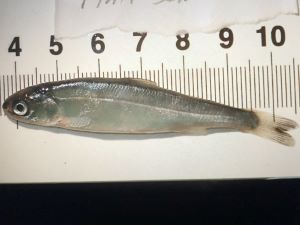FirstArcticJuvenilePacificSalmon_crop_edit.jpg

Chum salmon are typically found in Alaska, but recently, juveniles have been found northward, indicating a shift in the population distribution. Credit: Vanessa von Biela, U.S. Geological Survey.
A single fish that’s only two and a half inches long doesn’t usually generate much excitement. But a juvenile chum salmon found off the northern coast of Alaska created some scientific buzz. It suggests that the species is expanding its range northward in response to our warming climate.
Many species are moving to find comfortable temperatures—from insects to birds to fish. Chum salmon is one of many species of Pacific salmon found along the coasts of the northern United States and Canada. Some of the species have started expanding deeper into Arctic waters, and spawning in rivers in northern Alaska.
Adult chum salmon have been seen in some of those waters as well. But scientists haven’t been sure whether that meant the species was actually expanding its range. To be sure, they needed to see evidence that chum salmon were reproducing in that area.
And that’s where the little guy came in. It was caught in 2017. Scientists analyzed its DNA to confirm its species. They then examined its otolith—a small bony structure in its head. It’s made of layers. Like the rings in a tree, each layer holds information about the conditions in which it formed. That helps biologists trace the fish’s origin, development, and movements.
The chemistry of the otolith suggested the juvenile had hatched in the Mackenzie River of northern Alaska—a place where no chum had been seen to hatch before. So that’s an indication that chum salmon are shifting north to find comfy waters.

